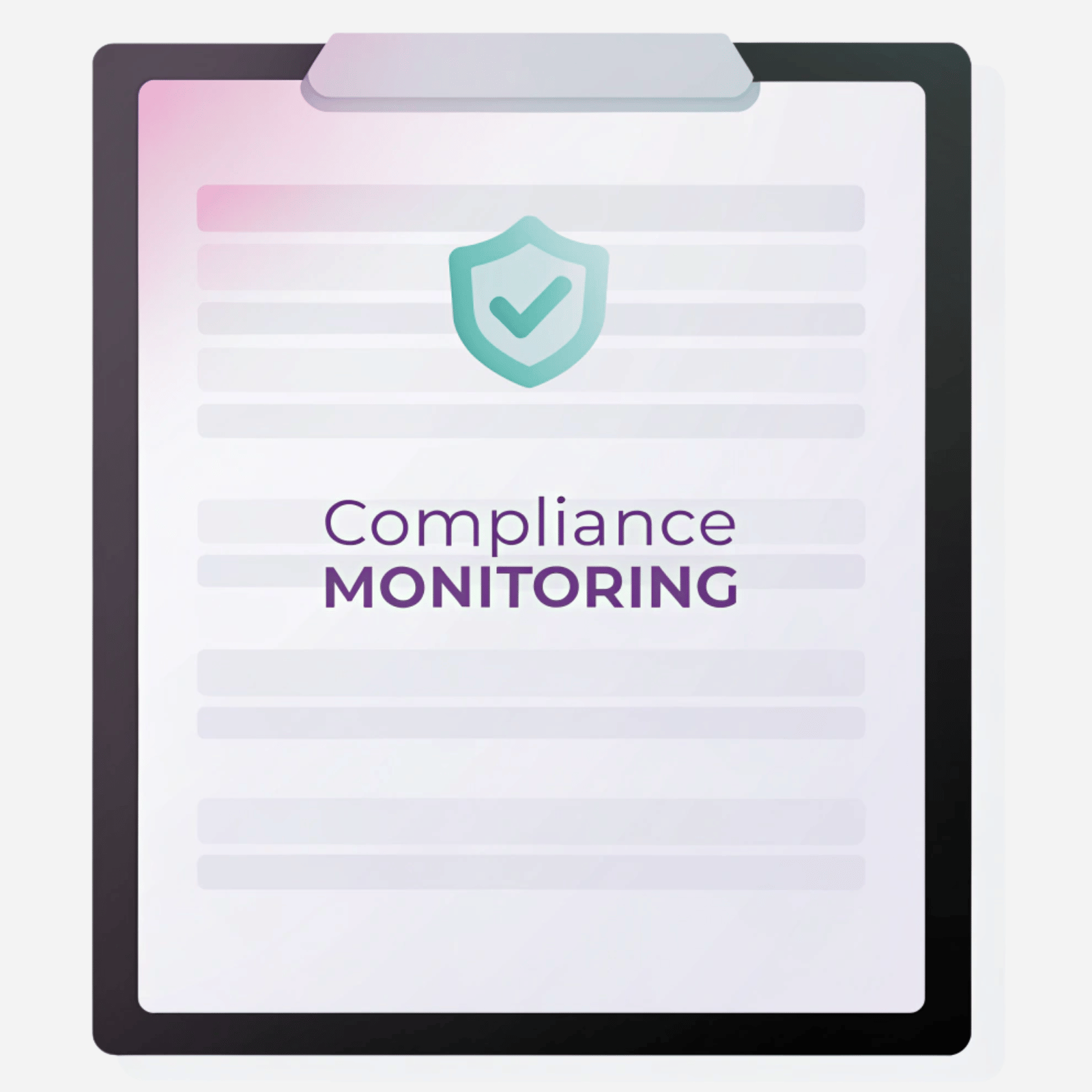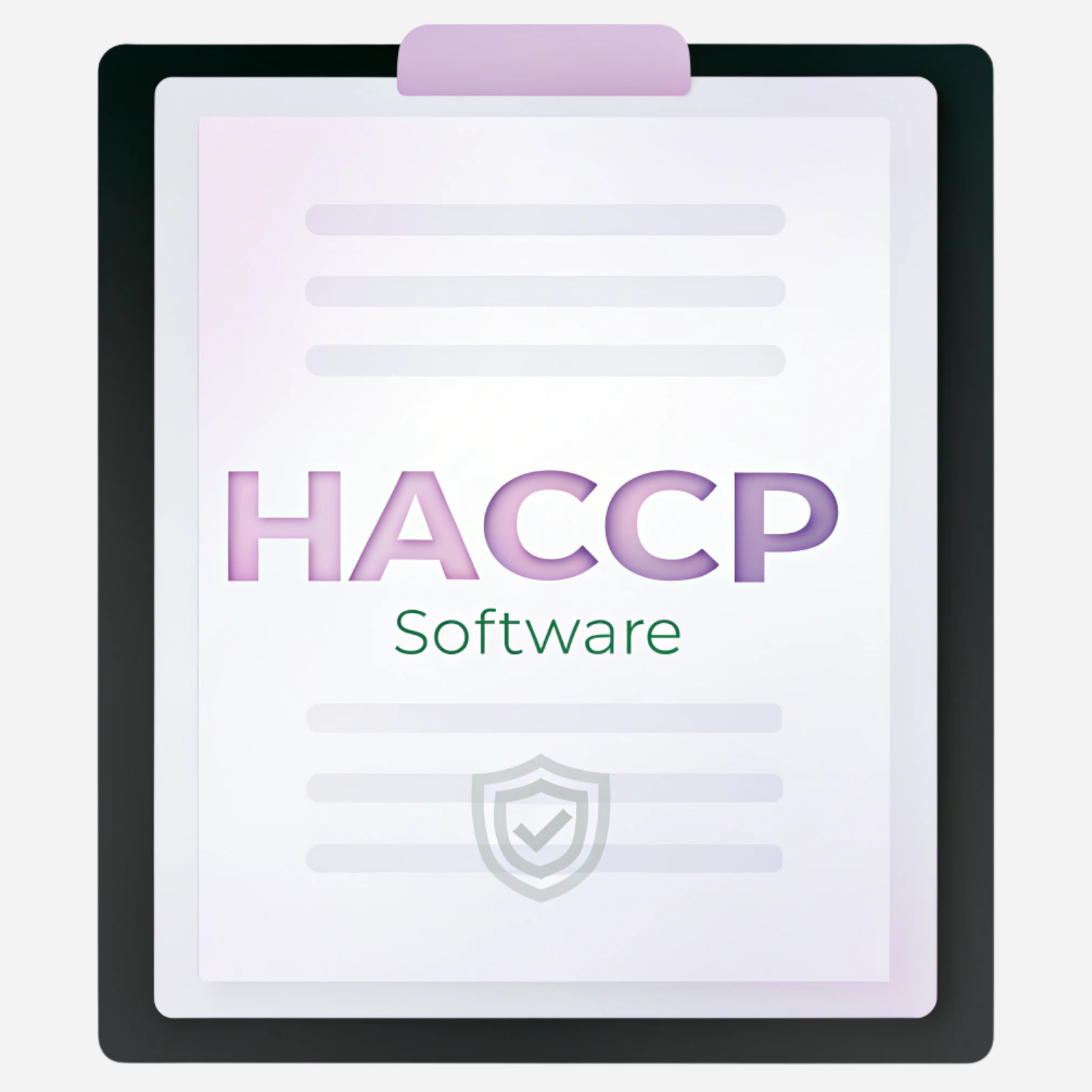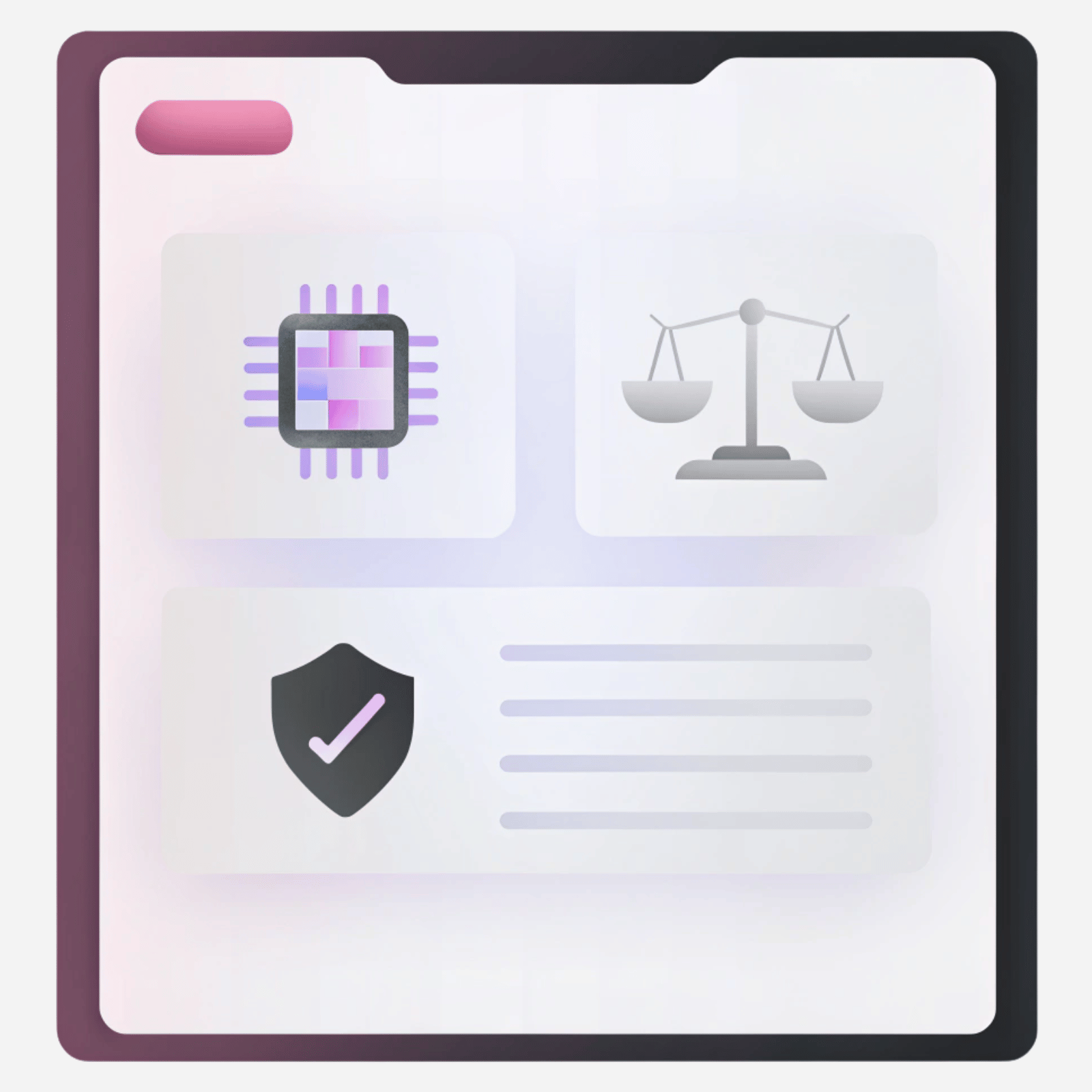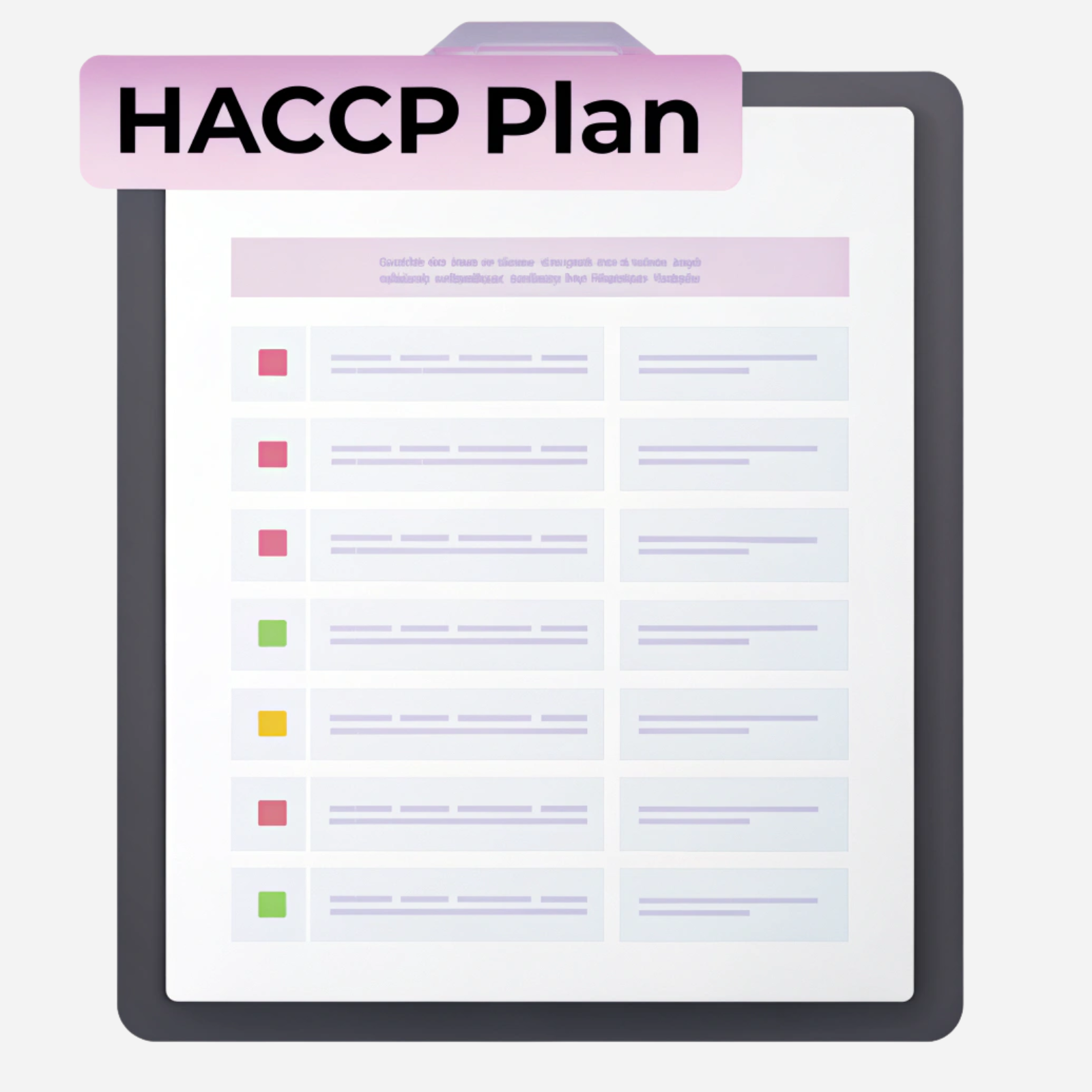
What is HACCP and Why It Matters
When it comes to food safety, having a clear system in place can make all the difference. HACCP is a food safety system designed to prevent hazards before they affect your product. Instead of relying on end-product testing, the HACCP approach focuses on controlling risks throughout the entire food production process.
A basic HACCP plan provides a structured approach to identifying critical points where contamination can occur and demonstrates how to control them. Whether you're running a small product or managing a full-scale facility, building a HACCP plan helps you meet strict HACCP food standards, improve operational efficiency, and increase trust in your brand.
An effective HACCP plan is about creating safe workflows, protecting public health, and ensuring long-term success. If you're developing a HACCP plan for the first time, understanding how and why it works is your first step toward building a reliable and responsible food production system.
The 7 Principles of a Basic HACCP Plan
Now that you understand why HACCP is a trusted food safety system, the next step is learning how to apply it.
At the core of every effective HACCP plan are seven key principles - practical steps that guide you through hazard prevention, control, and monitoring.
These principles aren’t just theoretical. They form the backbone of developing a HACCP plan that aligns with international HACCP food standards and helps you stay audit-ready. Whether you're building a HACCP plan from scratch or updating an existing one, understanding these steps gives you a clear roadmap toward safer, more reliable food production.
Let’s explore how each principle fits into the HACCP approach and what role it plays in shaping a basic HACCP plan that works, from hazard analysis to corrective actions.
Each of the seven principles plays a critical role in building a HACCP plan that protects your product, your customers, and your business.
Let’s walk through them step by step:
1. Conduct a Hazard Analysis: The first step in developing a HACCP plan is identifying potential biological, chemical, or physical hazards at each stage of your production process. This helps you understand where things can go wrong - and what you need to do to prevent it.
2. Identify Critical Control Points (CCPs): CCPs are the specific stages in your process where control is essential to prevent or eliminate a hazard. Pinpointing these moments is key to an effective HACCP plan.
3. Establish Critical Limits: Each CCP must have a measurable limit, such as temperature, pH, or time, that separates safe from unsafe. These critical limits are based on HACCP food standards and provide clear benchmarks for food safety.
4. Monitor CCPs: The HACCP approach emphasizes consistent monitoring. Whether through manual checks or automated systems, tracking each CCP ensures your process stays within safe limits.
5. Establish Corrective Actions: If something goes wrong, say a temperature drops below the required limit, your plan must include what action to take. This ensures safety isn’t compromised and supports quick recovery.
6. Verify the System: Verification confirms that your HACCP system is working as intended. This might include reviewing records, calibrating equipment, or running internal audits - all essential for building a HACCP plan that meets regulatory expectations.
7. Keep Detailed Records: Documentation is a cornerstone of a basic HACCP plan. Good records prove that procedures were followed, help identify trends, and make audits smoother. They’re also vital for meeting HACCP food standards.
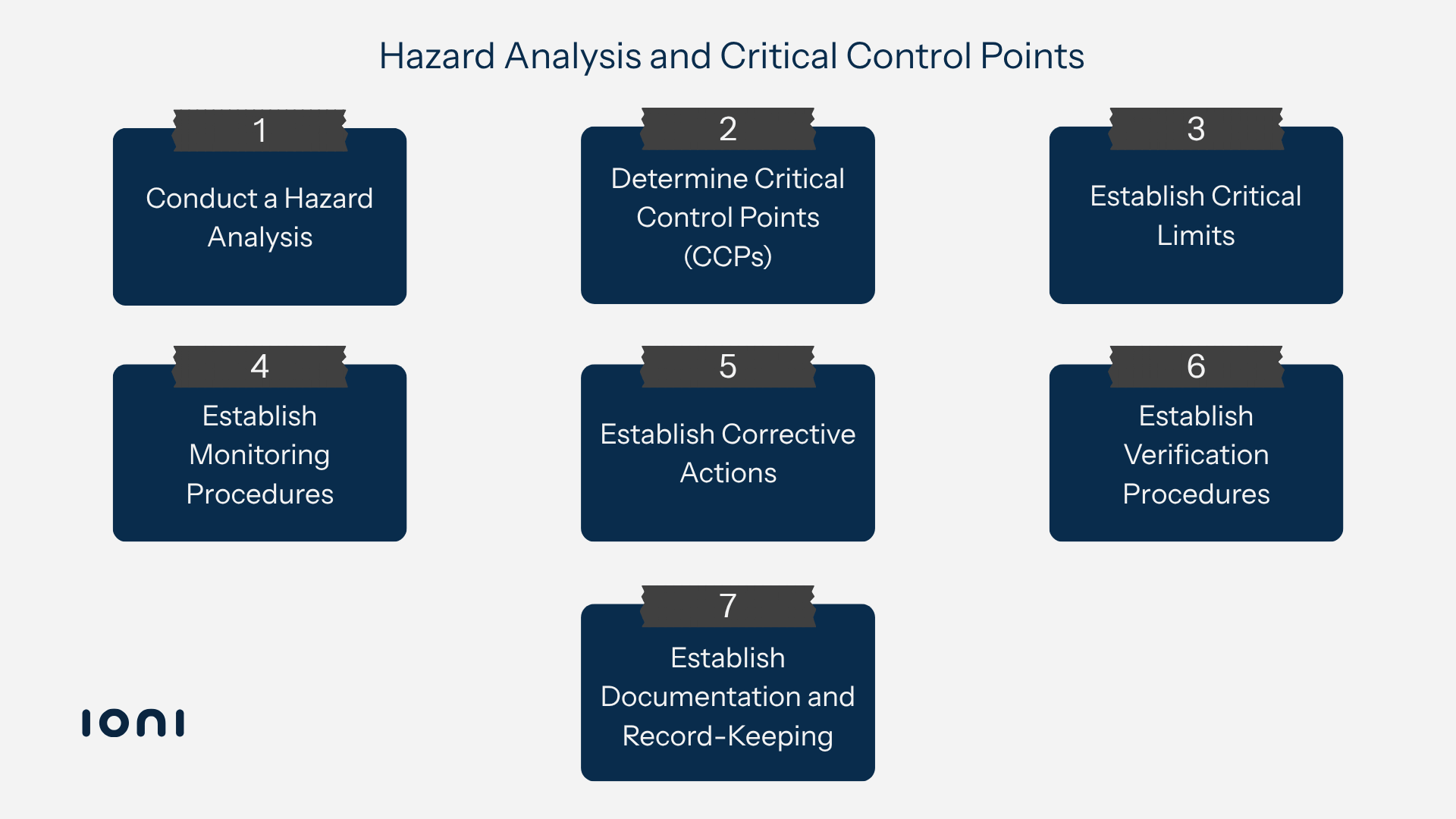
Building a HACCP Plan: Step-by-Step Process
Knowing the 7 principles is only part of the journey. To truly benefit from the HACCP approach, you need to apply it in practice. Whether you’re setting up your first system or refining an existing one, building a HACCP plan from scratch becomes much easier when broken down into clear, structured steps.
This section guides you through developing a HACCP plan that meets international HACCP food standards, using proven methods, ready-to-use templates, and practical tools. With the right resources, even a basic HACCP plan can become an effective HACCP plan, ready for audits and real-world challenges.
Step-by-Step Process for Building a HACCP Plan
Part 1: Preliminary Steps (Steps 1–5)
Before applying the core HACCP principles, it’s important to lay a solid foundation through preliminary work that supports your HACCP system.
Step 1: Develop Fundamental Prerequisite Programs
These establishment-wide programs include Sanitation Standard Operating Procedures (SOPs), Good Manufacturing Practices (GMPs), allergen control, pest control, and more. Such programs provide the essential groundwork for your HACCP system and help justify why some hazards are not reasonably likely to occur. This foundational work is key to building a HACCP plan that is both practical and compliant with HACCP food standards.
Step 2: Assemble the HACCP Team
Form a cross-functional team representing production, quality, sanitation, and other key areas. At least one team member should be trained in HACCP according to 9 CFR 417.7(b) - a U.S. regulation for meat and poultry processing plants. If you operate outside the USA, check your local HACCP training requirements. Cultivating a strong food safety culture across your establishment ensures everyone understands their role in supporting the HACCP system, which is critical for developing a HACCP plan that works in practice.
Step 3: Describe the Food, Its Production, Distribution, Intended Use, and Consumers
Provide a detailed description of your products, including types, processing steps, packaging, shelf life, and storage or distribution conditions. Consider who the end users are, such as retail customers, institutions, or vulnerable populations like hospitals or schools. This information shapes the scope of your basic HACCP plan and helps focus the analysis on relevant risks.
Step 4: Develop and Verify Process Flow Diagrams
Create comprehensive flow charts illustrating every step of your production process, including the handling of materials, packaging, rework, and any interventions. Then, conduct a physical walkthrough of your facility to verify that the flow diagram accurately reflects actual operations. This ensures your HACCP approach is based on a true representation of your production environment.
Step 5: Group Products by Process Category
Identify the appropriate process category for each product according to regulatory classifications (for example, 9 CFR 417.2(b)(1) in the USA), such as slaughter, raw intact/non-intact products, thermally processed commercially sterile, fully cooked but not shelf stable, etc. Grouping products with similar processes and hazards allows you to create shared HACCP plans where applicable, streamlining your food safety management.
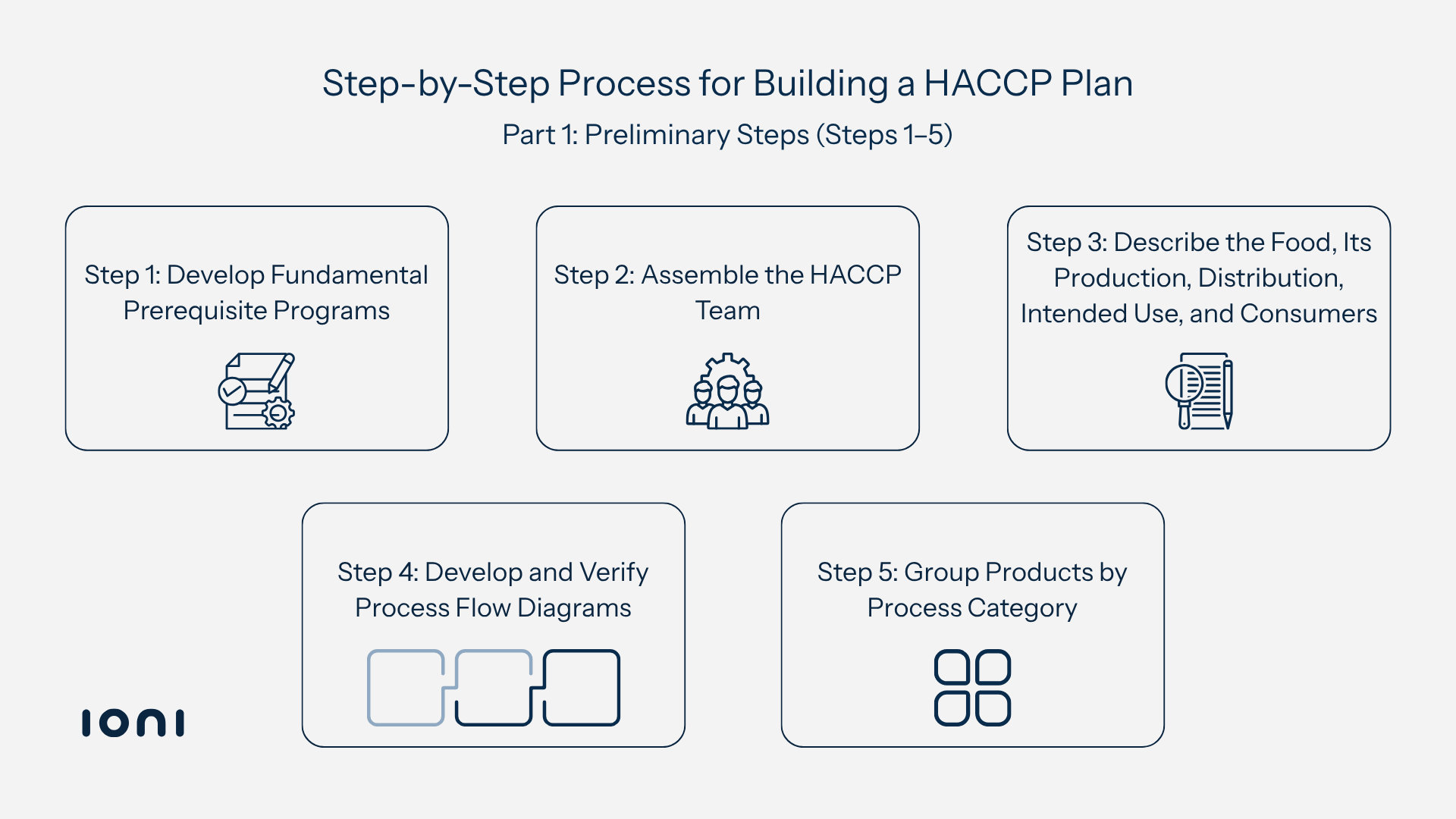
Part 2: Applying the Seven HACCP Principles (Steps 6–12)
Once preliminary steps are complete, you apply the core HACCP principles to identify and control food safety hazards systematically.
Step 6: Conduct a Hazard Analysis (Principle 1)
Effective hazard identification and hazard analysis are keys to a successful HACCP plan. Consider all real or potential hazards that may occur in each ingredient and at every stage of the commodity system. Food safety hazards for HACCP programs fall into three main categories:
- Biological hazards: These typically include foodborne bacterial pathogens such as Salmonella, Listeria, and E. coli, as well as viruses, algae, parasites, and fungi.
- Chemical hazards: These include naturally occurring chemicals like cyanides in some root crops, allergenic compounds such as peanuts, toxins produced by microorganisms (mycotoxins, algal toxins), and chemicals added intentionally (e.g., fungicides, insecticides).
- Physical hazards: Contaminants like broken glass, metal fragments, insects, or stones.
For each hazard, determine whether it is “reasonably likely to occur” (RLTO) and justify your decisions with scientific evidence. Use your prerequisite programs to support decisions where hazards are not RLTO. This detailed hazard analysis is central to developing an effective HACCP plan.
Step 7: Identify Critical Control Points (CCPs) (Principle 2)
Using decision trees or worksheets, determine the points in the process where hazards can be prevented, eliminated, or reduced to acceptable levels. Every hazard identified as an RLTO must be controlled at a CCP. This step is crucial in shaping an effective HACCP plan aligned with the HACCP food standards.
Step 8: Establish Critical Limits for Each CCP (Principle 3)
Define clear, measurable limits such as temperature, time, pH, or other parameters that separate safe from unsafe conditions at each CCP. These critical limits are the benchmarks your team will use to verify control.
Step 9: Establish Monitoring Procedures (Principle 4)
Detail how each CCP will be monitored to ensure it stays within its critical limits. Specify who will monitor, how often, and by what method (e.g., temperature checks, visual inspections). Consistent monitoring is essential for maintaining an effective HACCP plan.
Step 10: Establish Corrective Actions (Principle 5)
Outline the exact steps to be taken if monitoring shows a CCP is out of control. This includes actions to correct the process, disposition of affected products, and thorough documentation. Clear corrective actions ensure that deviations do not compromise food safety.
Step 11: Establish Verification Procedures (Principle 6)
Once the HACCP plan has been developed and all CCPs validated, the complete plan must be verified before and during routine operation. Verification is the responsibility of the person(s) in charge of each part of the commodity system and ensures that CCPs and control measures are appropriate and effective. Verification activities include:
- Collecting samples for analysis by methods different from routine monitoring
- Interviewing staff, especially those monitoring CCPs
- Observing operations at CCPs in real-time
- Conducting formal internal audits, possibly by independent auditors
Microbiological or chemical testing can confirm the plan’s effectiveness and product compliance with customer specifications. Regular review and verification help keep the HACCP plan current, reflecting any changes in product formulation or process.
Step 12: Establish Recordkeeping Procedures (Principle 7)
Maintain complete and accurate records of hazard analyses, CCP monitoring, corrective actions, verification activities, and supporting documents. Records must comply with regulatory requirements (e.g., 9 CFR 417.5 in the USA) and serve as evidence that your food safety controls are in place and effective.
By following these detailed steps and tailoring them to your local regulatory environment, you can create a basic HACCP plan that protects your customers and meets global food safety standards. This structured method of building a HACCP plan supports your operation’s safety, compliance, and reputation.
Building a HACCP plan traditionally requires meticulous attention to detail and a deep understanding of food safety standards. After mastering the foundational steps and principles of developing a HACCP plan, it’s clear that while effective, this process can be time-consuming and complex. That’s where innovation steps in to transform the way we approach food safety.
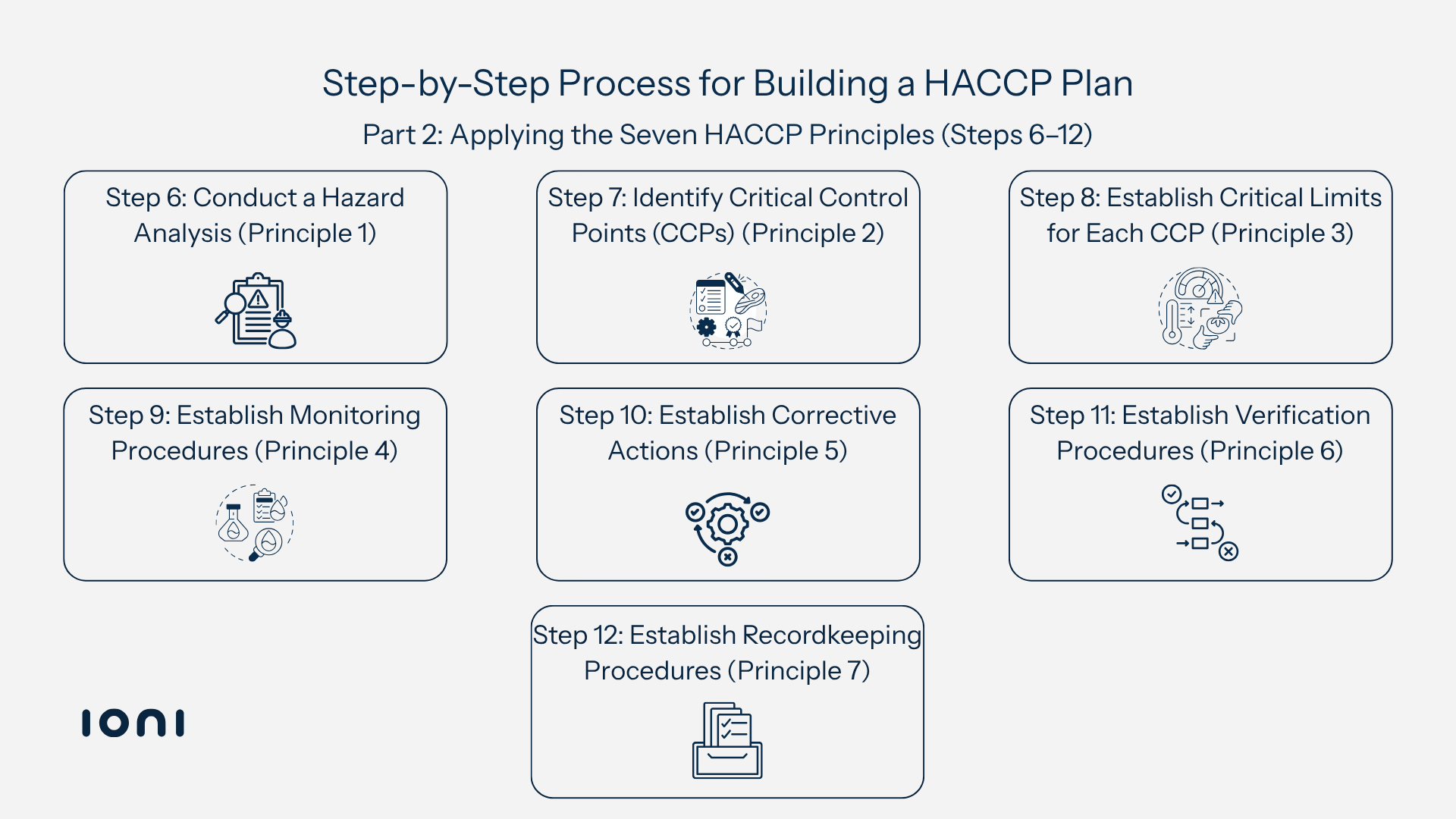
How AI Is Changing the Way We Build HACCP Plans
Enter the AI HACCP Builder - IONI. This powerful tool is designed to streamline and simplify the entire building a HACCP plan journey by automating many of the manual tasks that often slow down compliance efforts. With IONI, food producers can create a basic HACCP plan that meets rigorous HACCP food standards more quickly and accurately, without sacrificing quality or thoroughness.
Faster and smarter compliance is now achievable as the AI-driven platform analyzes your processes, identifies hazards, and suggests critical control points aligned with your specific operation. This intelligent automation supports the HACCP approach by reducing human error and freeing up valuable time for teams to focus on other essential food safety activities.
So, who should consider using an AI-powered solution like IONI? Whether you’re a small producer developing your first basic HACCP plan or an experienced food safety manager refining an effective HACCP plan, leveraging AI can boost efficiency and confidence. Embracing technology in developing a HACCP plan offers a forward-thinking way to meet compliance and ensure food safety in today’s dynamic industry.
Let’s explore how IONI transforms each key element of an effective HACCP plan:
a) Hazard Analysis: Identifying Food Safety Risks
Every basic HACCP plan starts with hazard analysis.
- Upload Your SOPs & Docs: Instead of starting from scratch, the user uploads existing SOPs, GMPs, or other relevant documents. IONI parses these materials automatically.
- Extracted Hazards: The system identifies potential biological (e.g., Salmonella, Listeria), chemical (e.g., mycotoxins, allergens), and physical (e.g., metal fragments, glass) hazards mentioned or implied in the documents.
- Smart Suggestions: If the uploaded docs lack coverage for typical hazards in a process step (e.g., reheating), IONI highlights the gap and recommends updates. The user simply clicks "Apply," and the system adds the hazard or creates a new process step.
- Fully Customizable: All recommendations are editable, so users retain full control over final decisions.
Result: A deep, contextualized hazard analysis without missing critical risks - all streamlined through automation.
b) Critical Control Points (CCPs) and Limits
Determining CCPs can be one of the most complex parts of developing a HACCP plan, especially when done manually.
- AI-Powered Decision Support: Once hazards are matched to process steps, IONI helps determine whether they require CCPs using decision trees and logic models trained on food industry best practices.
- Critical Limits Definition: IONI suggests appropriate limits (e.g., time, temperature, pH) and sources them from regulatory standards or previous validated documents.
- Validation & Adjustment: Users can modify values or manually input alternatives, while the system ensures all critical points are logically and legally sound.
Result: An effective HACCP plan that identifies and enforces strong, data-backed critical limits at every CCP.
c) Monitoring, Corrective Actions, and Verification
Ensuring that the HACCP system runs smoothly over time is vital. IONI helps automate and monitor these dynamic stages:
- Set up Monitoring Plans: For every CCP, the system generates monitoring protocols and auto-fills who, what, how, and how often to check.
- Corrective Action Triggers: If a deviation is detected, IONI suggests corrective actions based on industry norms or past incidents.
- Automated Verification Support: IONI tracks progress, highlights weak spots, and guides the user in reviewing incomplete or missing documentation.
- Color-Coded System Health: Each section of the plan is visually flagged - incomplete, partially complete, or validated - helping the user track what still needs review.
Result: Continuous improvement and live system status that supports a verified, resilient HACCP approach.
d) Record-Keeping and Documentation Best Practices
Good documentation is proof that your system works. IONI automates recordkeeping so you stay audit-ready.
- End-to-End Document Generation: From product descriptions to CCP logs and SOPs, IONI generates printable PDF outputs that cover the full HACCP lifecycle.
- GMP/GHP/CCP Logs: The system proposes formats for tracking daily operations, which can be exported or integrated into a future QMS.
- Smart GAP Detection: If your plan is missing something (e.g., a sanitation SOP for a heating step), IONI alerts you and offers to generate the document.
- Full Transparency: You can view, edit, or regenerate all forms. The system is built to scale, from small producers to enterprise-level manufacturing.
Result: A full digital paper trail with customizable forms, compliant with regulators and ready for audits.
e) From Setup to Final Plan – With AI on Your Side
Unlike basic template solutions, IONI builds your HACCP plan from real inputs. It interprets your SOPs, helps you structure process flows, and validates each decision along the way.
When everything is complete, you simply click Generate, and IONI produces a full, audit-ready set of documents - including hazard analyses, flow diagrams, team info, CCP tables, verification plans, and more.
Who May Use an AI-Powered HACCP Solution?
- Small producers looking to comply with food laws quickly
- Experienced teams seeking a faster way to update existing plans
- Operations scaling production across multiple product lines
- Consultants who manage HACCP for clients and need flexible automation
With IONI, building a HACCP plan becomes less about forms and more about food safety strategy. It guides users through developing a HACCP plan step by step, with all the power of automation, real-time analysis, and human oversight combined.
Watch How IONI Works
See AI in action! In the video below, you can watch how AI streamlines the process of building HACCP plans, from identifying hazards to creating compliant documentation - all faster and smarter than traditional methods.
Tips for Maintaining an Effective HACCP Plan
Maintaining a HACCP system goes beyond initial setup. Whether you're building a HACCP plan for the first time or refining an existing one, long-term success depends on keeping your system accurate, up to date, and aligned with HACCP food standards. A strong HACCP approach evolves with your processes, your people, and your products.
Here are the core strategies for keeping your basic HACCP plan effective and audit-ready:
1. Schedule Regular Reviews and Updates
Your operations aren’t frozen in time - your HACCP plan shouldn’t be either. New products, equipment, suppliers, or processes can introduce different risks or eliminate previous ones.
Set a review schedule - quarterly, biannually, or aligned with seasonal production shifts - and revisit your hazard analysis, critical control points, and documentation to ensure everything is still valid.
Tip: Document every review, even if no changes are made. This shows auditors your commitment to continuous improvement.
2. Train Your Team and Assign Responsibility
An effective HACCP plan depends on people, not just paperwork. Every team member should understand the role they play in food safety, especially those responsible for monitoring critical control points or responding to deviations.
Make HACCP training part of onboarding for new staff and a recurring activity for current employees.
Tip: Use examples from your own HACCP plan to demonstrate how everyday actions connect directly to food safety.
3. Keep Documentation Organized and Accessible
Accurate, consistent records prove that your HACCP system is working. From monitoring logs to corrective action reports, every piece of documentation should be easy to find, complete, and up to date.
Whether you use digital records or printed forms, make sure documentation is maintained daily, not just before an audit. Keep templates for CCP monitoring, verification, training logs, and product traceability forms standardized across your team.
Tip: Perform random spot checks of documentation to identify inconsistencies before they become compliance issues.
4. Reassess Hazards as Needed
While regular reviews are critical, certain events may call for unscheduled reassessment. Changes in raw materials, unexpected product failures, or feedback from customers can signal the need to revisit your hazard analysis.
Updating your hazard identification and CCP definitions ensures that your basic HACCP plan remains accurate, especially when risk factors shift.
Maintaining a HACCP system is an ongoing commitment. By reviewing your process regularly, keeping your team informed, and staying on top of documentation, you're building a reliable foundation for food safety success.
Conclusion: Getting Started with Your Own Basic HACCP Plan
Creating a HACCP system from the ground up may seem complex at first, but now you’ve seen that with a clear structure, practical tools, and a step-by-step process, it becomes entirely achievable. Whether you’re managing a small food business or scaling production, building a HACCP plan is a smart investment in safety, trust, and long-term success.
By understanding how each part fits together - from hazard analysis and CCPs to documentation and staff training - you're now equipped to begin developing a HACCP plan that meets real operational needs and aligns with recognized HACCP food standards.
Remember: a basic HACCP plan doesn’t need to be perfect from day one. What matters is that it reflects your processes, evolves as you grow, and stays active through regular reviews and training. The strength of the HACCP approach lies in its flexibility - and in your commitment to maintaining it.
So, take that first step. Map out your process, gather your documents, and begin shaping a system that protects your food and strengthens your business. With each action you take, you’re building an effective HACCP plan designed for real-world food safety.
FAQs About HACCP for Beginners
How long does it typically take to complete building a HACCP plan?
The time needed to develop a basic HACCP plan varies depending on the complexity of your operations and available resources. Small producers might complete a plan in a few weeks, while larger facilities may take several months. The key is a systematic approach to ensure all hazards and controls are thoroughly addressed.
How often should I update my HACCP plan to meet current HACCP food standards?
Regular updates are important - ideally at least once a year or whenever you make significant changes to products or processes. Staying current ensures your effective HACCP plan continues to comply with evolving regulations and food safety best practices.
Does HACCP apply to all types of food businesses?
Yes, HACCP is an internationally recognized system designed for all food sectors - from farming and processing to packaging and distribution. Tailoring the plan to your specific operation is part of building a HACCP plan that works for you.


